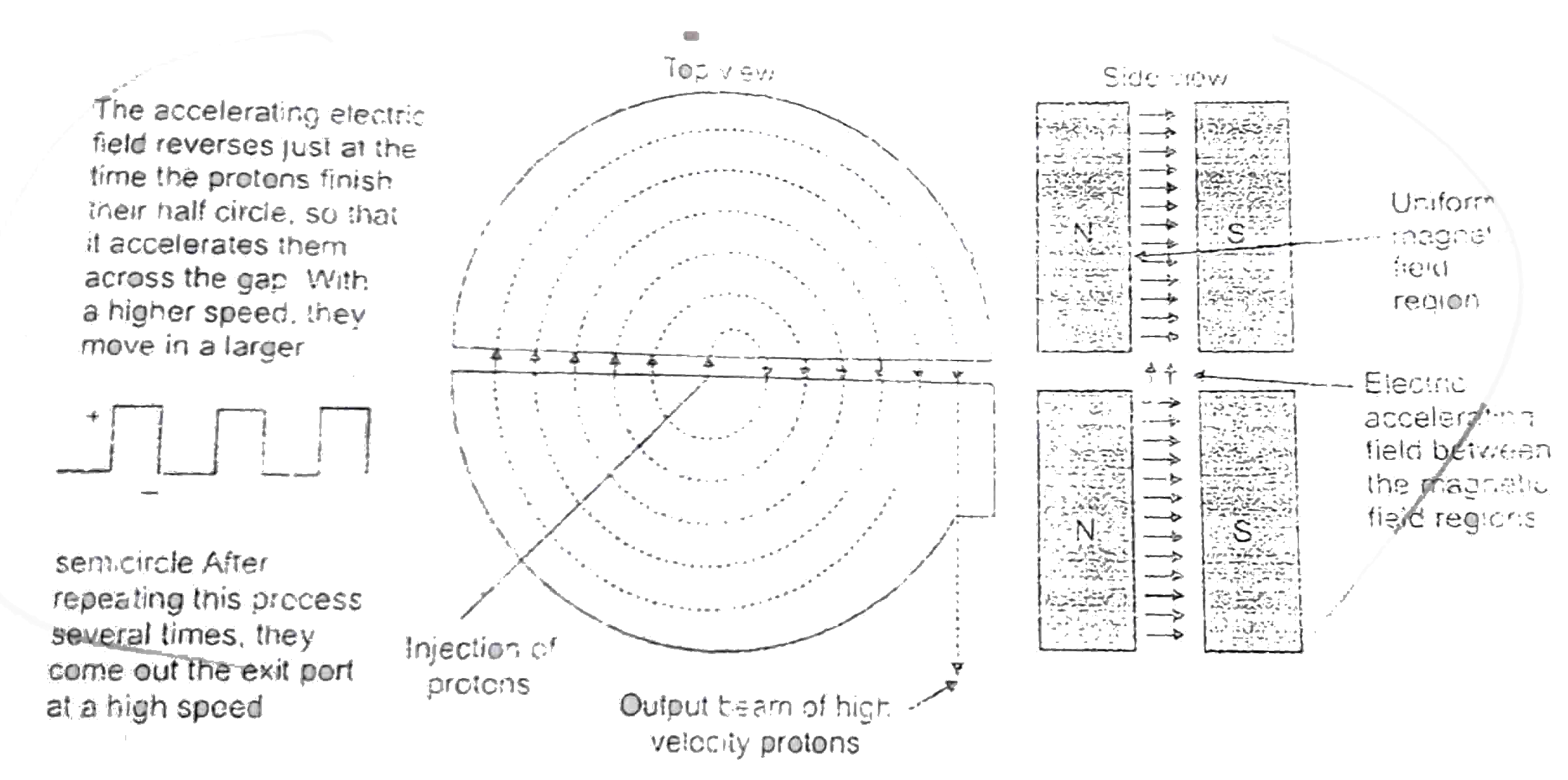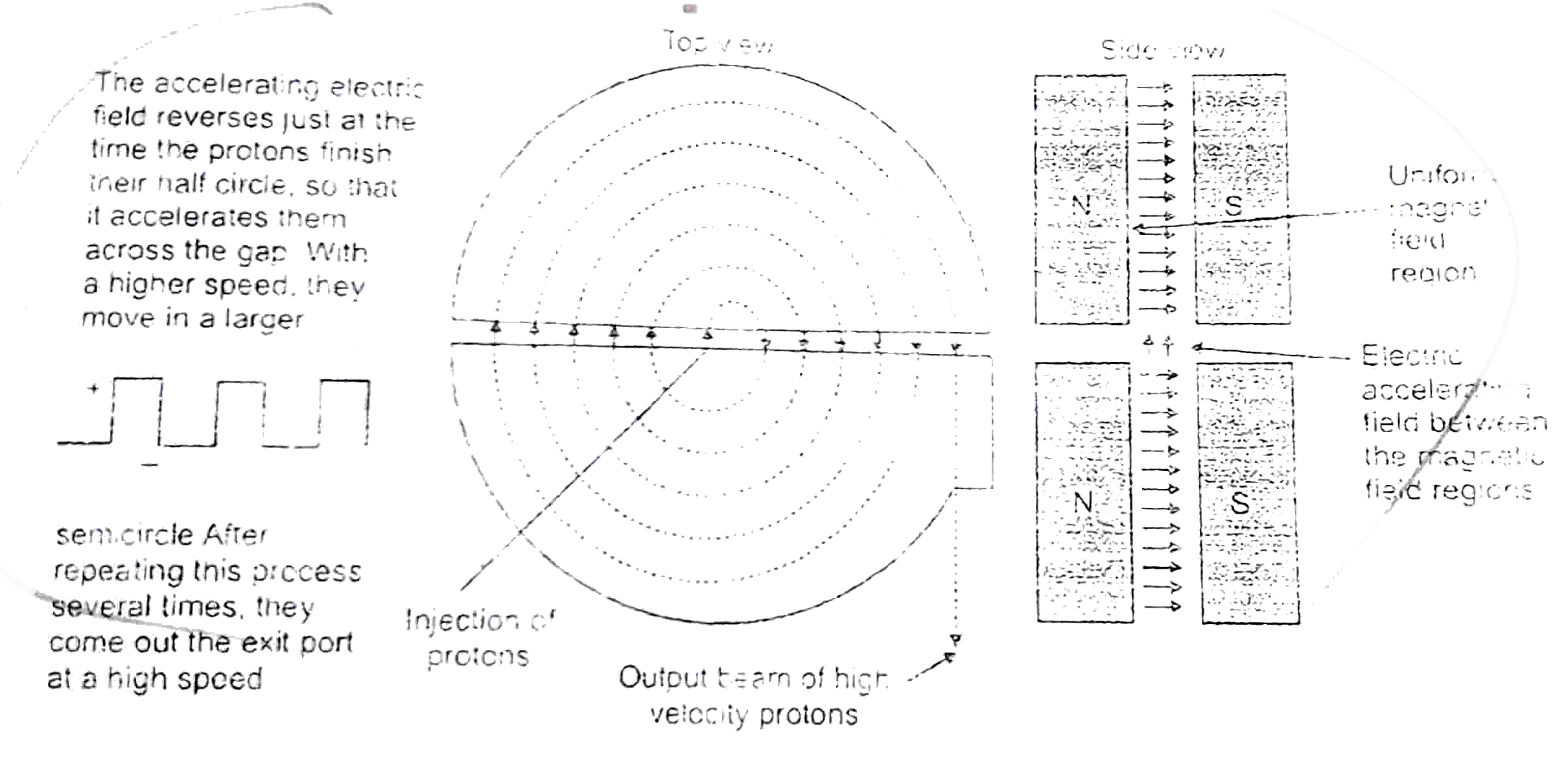If the maximum value of accelerating potential provided by a radio frequency oscillator is 12 kV. The number of revolution made by a proton in a cyclotron to achieve one sixth of the speed of light is _______
To solve the problem, we need to determine the number of revolutions made by a proton in a cyclotron to achieve one sixth of the speed of light (v = c/6) when the maximum accelerating potential is 12 kV.
1. Identify Given Values:
- Maximum accelerating potential (V) = 12 kV = 12 × 10^3 V
- Speed of light (c) = 3 × 10^8 m/s
- Desired speed of proton (v) = c/6 = (3 × 10^8 m/s) / 6 = 5 × 10^7 m/s
2. Calculate Kinetic Energy of Proton:
The kinetic energy (KE) of the proton when it reaches the speed v is given by:
KE=12mv2
where m is the mass of the proton (approximately 1.67×10−27 kg).
KE=12×1.67×10−27×(5×107)2
KE=12×1.67×10−27×2.5×1015=2.0875×10−12 J
3. Calculate Energy Gained from the Electric Field:
The energy gained by the proton in one revolution due to the potential difference is given by:
Energy gained per revolution=qV
where q is the charge of the proton (approximately 1.6×10−19 C).
Energy gained per revolution=(1.6×10−19 C)×(12×103 V)=1.92×10−15 J
4. Relate Kinetic Energy to Energy Gained:
The total kinetic energy gained by the proton after n revolutions is:
KE=n×(qV)
Setting the kinetic energy equal to the energy gained:
2.0875×10−12=n×(1.92×10−15)
5. Solve for n:
n=2.0875×10−121.92×10−15≈1082.64
Rounding to the nearest whole number, we find:
n≈1083
Final Answer:
The number of revolutions made by a proton in a cyclotron to achieve one sixth of the speed of light is approximately 1083.
- Maximum accelerating potential (V) = 12 kV = 12 × 10^3 V
- Speed of light (c) = 3 × 10^8 m/s
- Desired speed of proton (v) = c/6 = (3 × 10^8 m/s) / 6 = 5 × 10^7 m/s
The kinetic energy (KE) of the proton when it reaches the speed v is given by:
KE=12mv2
where m is the mass of the proton (approximately 1.67×10−27 kg).
KE=12×1.67×10−27×(5×107)2
KE=12×1.67×10−27×2.5×1015=2.0875×10−12 J
The energy gained by the proton in one revolution due to the potential difference is given by:
Energy gained per revolution=qV
where q is the charge of the proton (approximately 1.6×10−19 C).
Energy gained per revolution=(1.6×10−19 C)×(12×103 V)=1.92×10−15 J
The total kinetic energy gained by the proton after n revolutions is:
KE=n×(qV)
Setting the kinetic energy equal to the energy gained:
2.0875×10−12=n×(1.92×10−15)
n=2.0875×10−121.92×10−15≈1082.64
Rounding to the nearest whole number, we find:
n≈1083
The number of revolutions made by a proton in a cyclotron to achieve one sixth of the speed of light is approximately 1083.
Topper's Solved these Questions
- JEE MAINS 2021BOOK - JEE MAINS PREVIOUS YEARCHAPTER - JEE MAINS 2021EXERCISE - Physics (Section A )
20 Videos
- JEE MAINS 2020BOOK - JEE MAINS PREVIOUS YEARCHAPTER - JEE MAINS 2020EXERCISE - PHYSICS
246 Videos
- JEE MAINS 2022BOOK - JEE MAINS PREVIOUS YEARCHAPTER - JEE MAINS 2022EXERCISE - PHYSICS (SECTION -B)
10 Videos
Similar Questions
If the maximum value of accelerating potential provided by a radio frequency oscillator be 25kV, find the number of revolutions made by a proton in a cyclotron to achieve one sixth of the speed of light. Mass of proton =1⋅67×10−27kg.
View SolutionIf the maximum value of accelerating potential provided by a radio frequency oscillator be 10kV, calculate the number of revolutions made by an α-particle in a cyclotron to achieve one-tenth of the speed of light. Mass of proton=1⋅67×10−27kg, charge on proton =1⋅6×10−19C.
View Solution
Knowledge Check
A car accelerates uniformly from rest to a speed of 10m/s in a time of 5 s .The number of revolutions made by one of its wheels during this motion if the radius of the wheel is 1/π m .
A50B25C12.5D6.25In the given figure of a cyclotron, showing the particle source S and the dees.A uniform magnetic field is directed up form the plane of the page.Circulating protons spiral outward within the hollow dees gaining energy every time they cross the gap between the dees.Suppose that a proton, injected by source S at the centre of the centre of the cyclotron in figure initially moves toward a negatively charged dee.It will accelerate toward this dee and enter it.Once inside, it is shielded from electric field by the copper walls of the dee,that is the electric field does not enter the dee.The magnetic field, however, is not screened by the (nonmagnetic) copper dee, so the proton moves in circular path whose radius, which depends on its speed, is given by
r=mvqB...(1)
Let us assume that at the instant the proton emerges into the center gap from the first dee, the potential difference between the dees is reversed.Thus, the proton again faces a negatively charged dee and is again accelerated.Thus,the proton again faces a negatively charged dee and is again accelerated.This process continues, the circulating proton always being in step.with the oscillations of the dee potential, until the proton has spiraled out to the edge of the dee system.There a deflector plate sends it out through a portal.The key to the operation of the cyclotron is that the frequency f at which the proton circulates in the field (and that does not depend on its speed) must be equal to the fixed frequency fosc of the electrical oscilliator, or f=fosc(resonance condition)...(2)
This resonance condition says that, if the energy of the circulating proton is to increase, energy must be fed to it at a frequency fosc that is equal to the natural frequency f at which the proton circulates in the magnetic field.
Combining equation 1 and 2 allows us to write the resonance condition as
qB=2πmfosc..(3)
For the proton, q and m are fixed.The oscillator (we assume) is designed to work at a single fixed frequency foscWe then "tune" the cyclotron by barying B until eq. 3 is satisfied and then many protons circulate through the magnetic field, to emerge as a beam.
For a given charge particle a cyclotron can be "tune" by:
 Achanging applied A.C. voltange onlyBchanging applied A.C. voltange and magnetic field bothCchanging applied magnetic field onlyDby changing frequency of applied A.C.
Achanging applied A.C. voltange onlyBchanging applied A.C. voltange and magnetic field bothCchanging applied magnetic field onlyDby changing frequency of applied A.C.In the given figure of a cyclotron, showing the particle source S and the dees.A uniform magnetic field is directed up form the plane of the page.Circulating protons spiral outward within the hollow dees gaining energy every time they cross the gap between the dees.Suppose that a proton, injected by source S at the centre of the centre of the cyclotron in figure initially moves toward a negatively charged dee.It will accelerate toward this dee and enter it.Once inside, it is shielded from electric field by the copper walls of the dee,that is the electric field does not enter the dee.The magnetic field, however, is not screened by the (nonmagnetic) copper dee, so the proton moves in circular path whose radius, which depends on its speed, is given by
r=mvqB...(1)
Let us assume that at the instant the proton emerges into the center gap from the first dee, the potential difference between the dees is reversed.Thus, the proton again faces a negatively charged dee and is again accelerated.Thus,the proton again faces a negatively charged dee and is again accelerated.This process continues, the circulating proton always being in step.with the oscillations of the dee potential, until the proton has spiraled out to the edge of the dee system.There a deflector plate sends it out through a portal.The key to the operation of the cyclotron is that the frequency f at which the proton circulates in the field (and that does not depend on its speed) must be equal to the fixed frequency fosc of the electrical oscilliator, or f=fosc(resonance condition)...(2)
This resonance condition says that, if the energy of the circulating proton is to increase, energy must be fed to it at a frequency fosc that is equal to the natural frequency f at which the proton circulates in the magnetic field.
Combining equation 1 and 2 allows us to write the resonance condition as
qB=2πmfosc..(3)
For the proton, q and m are fixed.The oscillator (we assume) is designed to work at a single fixed frequency foscWe then "tune" the cyclotron by barying B until eq. 3 is satisfied and then many protons circulate through the magnetic field, to emerge as a beam.
If q/m for a charge particle is 106,frequency of applied AC is 106Hz.Then applied magnetic field is
 A2π teslaBπ teslaC2 teslaDcan not be defined
A2π teslaBπ teslaC2 teslaDcan not be defined
In the Dubna heavy ion cyclotron neon ions are accelerated to an energy of 100 MeV. The diameter of the dees is 310 cm, the magnetic field induction in the gap is 1.1 T the accelerating potential is 300 kV. Find the degree of ionization of a neon atom, the total number of revolutions of an ion in the process of its acceleration and the frequency of the change in polarity of the accelerating field.
View Solution(a) Find the radius of Li(++) ions in its grounds state assuming Bohr's model to be valid.
(b) Find the maximum angular speed of the electron of a hydrogen atom in a stationary orbit.
(c ) Average lifetime of a H atom excited to n=2 state is 10−8 sec. Find the number of revolutions made by the electron on the average before it jumps to the ground state.
(d) Calculate the magnetic dipole moment corresponding to the motion of the electron in the ground state of a hydrogen atom.
(e) Using the known values for hydrogen atom, calculate :
(i) radius of third orbit for Li+2
(ii) speed of electron in fourth orbit for He+
View SolutionAn electron and a proton starting from rest get accelerated through potential difference of 100 kV. The final speeds of the electron and the proton are Ve and Vp respectively. Which one of the following relations is correct?
View SolutionFind the number of revolutions made by a proton in a cyclotron to attain one fourth of speed of light, if the maximum value of accelerating potential provided by the oscillator is 40 kV ? Take mass of the proton =1.67×10−27 kg .
View SolutionProtons are accelerated in a cyclotron so that the maximum curvature radius of their trajectory is equal to r=50cm. Find:
(a) the kinetic energy of the protons when the acceleration is completed if the magnetic induction in the cyclotron is B=1.0T,
(b) the minimum frequency of the cycloroton's oscillator at which the kinetic energy of the protons amounts to T=20MeV by the end of accelearation.
View Solution
